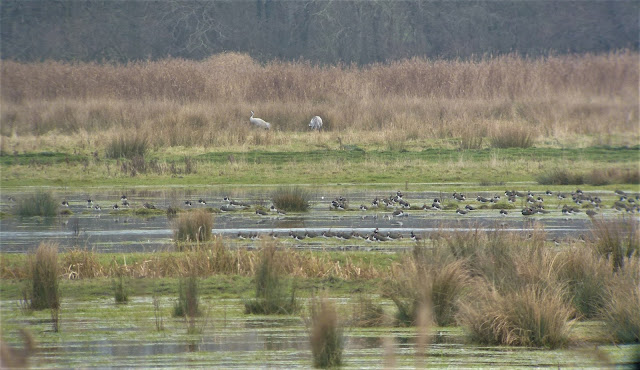The car park was busier than our seven Honeyguiders as a group of ramblers was also assembling. A couple of the ramblers enjoyed a telescope view of a treetop great spotted woodpecker before they set off on their clockwise circuit.
Our anti-clockwise route on this Honeyguide guided walk round NWT Upton Marshes started with a scan, revealing a star bird to start the day: a male hen harrier flying low across the grazing marshes. On the other side of Boat Dyke some fieldfares settled on a bush, though only those quick to the telescope saw them well before they flew off.
All morning there were high-flying pink-footed geese moving to and fro. There were also greylags out on the marsh, and later a flock flying in. These apart it was strangely quiet for wildfowl: just shelducks and mallards. The absence of wigeons, teals, shovelers and so on was a surprise, perhaps related to the mild autumn. Other birds on the marshes were a heron, little egret and mute swans, and we saw Chinese water deer several times.
A large flock of lapwings took to the air on several occasions: I estimated in the region 2,500. Perhaps they were disturbed by one of the local marsh harriers. There were at least three of these: a brown female or immature, a pale grey adult male and young male. Buzzards were all in the distance, including a pale individual on a pole.
 |
| Distant cranes and lapwings across the river on Oby Marshes. |
We’d reached the rather sticky path along the bank by the River Bure, and towards Oby Mill it was possible to scan Oby Marshes on the other side of the river. Here the lapwings had settled, and it was Jon who saw two cranes fly in. The cranes were distant though obvious enough through telescopes, and we were able to show them to some of the ramblers who were now coming past us. A kestrel settled on a perch across the river and bearded tits ‘pinged’ from the reeds, though didn’t reveal themselves.
We turned left by Tall Mill where the path runs by a gappy hedge, through which it was good place to see more pink-footed geese grazing. A rustle in some tall vegetation proved to be, as expected, another Chinese water deer.
 |
| Pink-footed geese, Upton Marshes. |
 |
| Pink-footed geese and a distant buzzard. |
We continued to Upton village, where group members enjoyed a coffee or a beer from the community shop or the White Horse pub with a few seasonal nibbles. Above the pub’s garden, a kestrel replaced a group of starlings at the top of a tree. There were goldfinches and a collared dove in the village as we walked back to the car park, pausing to sniff and photograph winter heliotrope on the verge by the final house. Ann treated us all to some bucks fizz to mark the winter solstice and pointed out two fungi species on a tree. The orange fungi from stumps were velvet shanks and the other was probably hairy curtain crust.
 |
| Winter heliotrope. |
Chris
Durdin




No comments:
Post a Comment